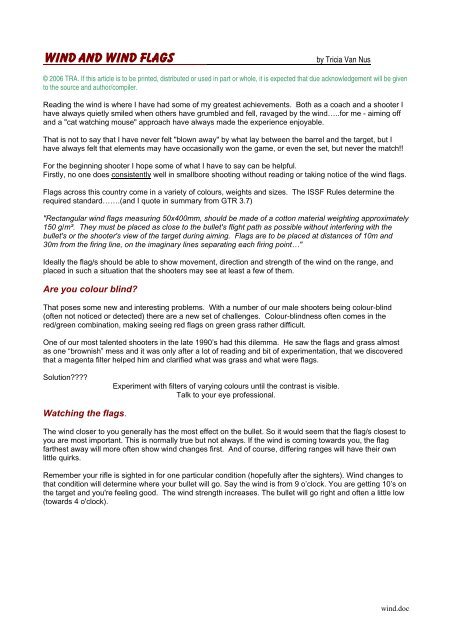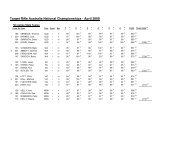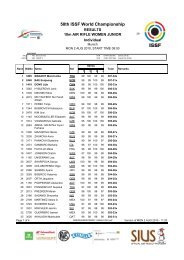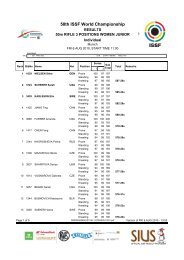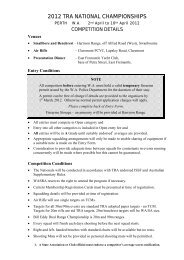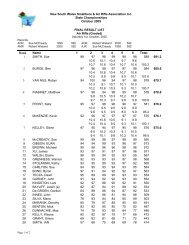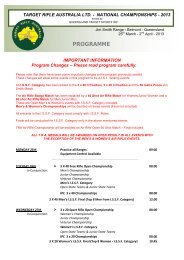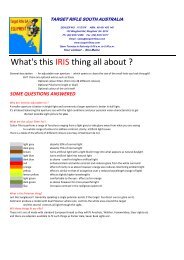Wind and Wind Flags - Target Rifle Australia
Wind and Wind Flags - Target Rifle Australia
Wind and Wind Flags - Target Rifle Australia
You also want an ePaper? Increase the reach of your titles
YUMPU automatically turns print PDFs into web optimized ePapers that Google loves.
<strong>Wind</strong> <strong>and</strong> <strong>Wind</strong> <strong>Flags</strong><br />
by Tricia Van Nus<br />
© 2006 TRA. If this article is to be printed, distributed or used in part or whole, it is expected that due acknowledgement will be given<br />
to the source <strong>and</strong> author/compiler.<br />
Reading the wind is where I have had some of my greatest achievements. Both as a coach <strong>and</strong> a shooter I<br />
have always quietly smiled when others have grumbled <strong>and</strong> fell, ravaged by the wind…..for me - aiming off<br />
<strong>and</strong> a "cat watching mouse" approach have always made the experience enjoyable.<br />
That is not to say that I have never felt "blown away" by what lay between the barrel <strong>and</strong> the target, but I<br />
have always felt that elements may have occasionally won the game, or even the set, but never the match!!<br />
For the beginning shooter I hope some of what I have to say can be helpful.<br />
Firstly, no one does consistently well in smallbore shooting without reading or taking notice of the wind flags.<br />
<strong>Flags</strong> across this country come in a variety of colours, weights <strong>and</strong> sizes. The ISSF Rules determine the<br />
required st<strong>and</strong>ard…….(<strong>and</strong> I quote in summary from GTR 3.7)<br />
"Rectangular wind flags measuring 50x400mm, should be made of a cotton material weighting approximately<br />
150 g/m². They must be placed as close to the bullet's flight path as possible without interfering with the<br />
bullet's or the shooter's view of the target during aiming. <strong>Flags</strong> are to be placed at distances of 10m <strong>and</strong><br />
30m from the firing line, on the imaginary lines separating each firing point…"<br />
Ideally the flag/s should be able to show movement, direction <strong>and</strong> strength of the wind on the range, <strong>and</strong><br />
placed in such a situation that the shooters may see at least a few of them.<br />
Are you colour blind<br />
That poses some new <strong>and</strong> interesting problems. With a number of our male shooters being colour-blind<br />
(often not noticed or detected) there are a new set of challenges. Colour-blindness often comes in the<br />
red/green combination, making seeing red flags on green grass rather difficult.<br />
One of our most talented shooters in the late 1990’s had this dilemma. He saw the flags <strong>and</strong> grass almost<br />
as one “brownish” mess <strong>and</strong> it was only after a lot of reading <strong>and</strong> bit of experimentation, that we discovered<br />
that a magenta filter helped him <strong>and</strong> clarified what was grass <strong>and</strong> what were flags.<br />
Solution<br />
Experiment with filters of varying colours until the contrast is visible.<br />
Talk to your eye professional.<br />
Watching the flags.<br />
The wind closer to you generally has the most effect on the bullet. So it would seem that the flag/s closest to<br />
you are most important. This is normally true but not always. If the wind is coming towards you, the flag<br />
farthest away will more often show wind changes first. And of course, differing ranges will have their own<br />
little quirks.<br />
Remember your rifle is sighted in for one particular condition (hopefully after the sighters). <strong>Wind</strong> changes to<br />
that condition will determine where your bullet will go. Say the wind is from 9 o’clock. You are getting 10’s on<br />
the target <strong>and</strong> you're feeling good. The wind strength increases. The bullet will go right <strong>and</strong> often a little low<br />
(towards 4 o'clock).<br />
wind.doc
So should you<br />
• Hold a little left <strong>and</strong> a little high for that condition <strong>and</strong> just shoot Probably not unless you have<br />
been confidently <strong>and</strong> successfully working on the concept of aiming off in your training (ask your coach<br />
about that concept)<br />
• Wait Yes briefly - maybe the original condition will come back in a few minutes. Best that you just<br />
watch the range conditions <strong>and</strong> wait for a moment to see what happens. Keep busy with good positive<br />
thoughts while you are waiting <strong>and</strong> watching.<br />
• Change the sights. Should the change seem to be permanent, then use your training knowledge,<br />
adjust your sights <strong>and</strong> fire a very good shot. This will give you valuable information about the wind<br />
change.<br />
The condition change I gave is a simple one - just a wind strength increase. However, the wind could have<br />
stayed the same velocity but shifted direction a little. More than likely it will do both at the same time! If you<br />
have watched <strong>and</strong> waited, <strong>and</strong> waited, <strong>and</strong> waited, then don’t be afraid to utilise the sights!!!! Based on your<br />
knowledge gained in training, you will be confident to make good sight corrections. Yes there are going to<br />
be times when the changes are very quick <strong>and</strong> you miss it - stay sharp <strong>and</strong> focused. Anger <strong>and</strong> frustration<br />
only compounds the effects of the elements.<br />
Remember when the wind blows <strong>and</strong>/or the rain belts down…<br />
• Keep your thoughts positive <strong>and</strong> take a diary down with you if you need to record how many clicks you<br />
adjust on the sights. Yes - with everything else going on, shooters often forget where they are, <strong>and</strong> once<br />
you are half way into a match (or even a 20 shot card) it is easy to forget where the sighter zero is.<br />
• The other shooters are also in the same range with you - they have their own little challenges.<br />
• Keep the flag/s in the one quadrant <strong>and</strong> try for consistency in firing the best shot you can.<br />
• You probably cannot see all the flags on the range, so watch a couple in your bay carefully, rather than<br />
all haphazardly.<br />
• The shots will move with the wind <strong>and</strong> the rain……work that to your advantage.<br />
• Rain will often "drop" the shots, just as wind will move them - learn from each shot.<br />
• Keep your shot quality very high - good process has the greatest chance of being good score outcome.<br />
• Use the time before, or in between details, to watch what is happening on the range. Be prepared - see<br />
how fast the flags move, or in what general directions.<br />
• Scope one of the "experts" for a bit <strong>and</strong> see what the flags are doing when they shoot - can you see<br />
their pattern<br />
One last thought that many shooters avoid……..<br />
Train in all sorts of conditions - wind, rain or sun<br />
wind.doc


